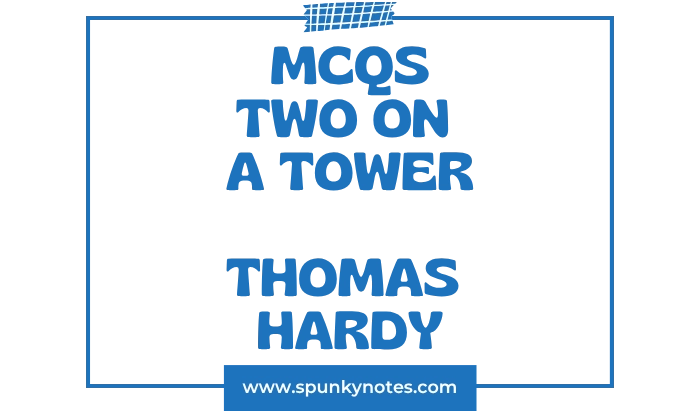
Estimated Reading Time: 17 min

Two on a Tower MCQs
1. Where does the story begin, as the lady’s carriage comes to a pause?
A. On a Wessex hill
B. Near a deep forest
C. In a busy town
D. Beside a river
2. What is the approximate age of the lady in the carriage?
A. Forty years old
B. Nine-and-twenty
C. Eighteen years old
D. Sixty-two years
3. What object dominates the central landscape viewed by the lady?
A. A winding road
B. A tower column
C. A vast manor
D. A winding river
4. What is the name of the lady’s residence?
A. The Manor Gate
B. Rings-Hill Speer
C. Welland House
D. Melchester Road
5. Why was the column built in the last century?
A. For astronomy
B. War memorial
C. For scenic view
D. For meditation
6. In what architectural style was the column built?
A. Corinthian order
B. Tuscan order
C. Ionic style
D. Saxon design
7. What was the state of the door leading into the tower on the lady’s first visit?
A. Solidly locked
B. Heavily bolted
C. Not fastened
D. Recently painted
8. What was the youth doing on the summit of the column?
A. Drawing scenery
B. Sitting on a stool
C. Reading a book
D. Singing hymns
9. What colour was Lady Constantine’s hair?
A. Flaxen yellow
B. Black as midnight
C. Bright auburn
D. Curly and light
10. What catastrophe did the youth first murmur that he observed through the telescope?
A. A lunar eclipse
B. A comet passing
C. A cyclone in the sun
D. A meteor shower
11. What is the column’s local name?
A. Constantine’s Spire
B. Rings-Hill Speer
C. Melchester Point
D. The Great Stand
12. What major role does Swithin aspire to achieve?
A. Royal Society member
B. Astronomy teacher
C. Observatory curator
D. Astronomer Royal
13. Swithin’s great work focuses primarily on what type of celestial body?
A. Comet analysis
B. Variable stars
C. Planet orbits
D. Fixed nebulae
14. What is the occupation of the labouring man, Haymoss Fry?
A. Parish clerk
B. Barley driller
C. Coachman
D. Building steward
15. Who is Swithin’s maternal grandfather?
A. Pa’son St Cleeve
B. Giles Martin
C. Sammy Blore
D. Mr Torkingham
16. What was Swithin’s father’s original profession?
A. A well-known lawyer
B. The parish curate
C. A popular doctor
D. A wealthy farmer
17. What did Swithin’s father do after marrying Farmer Martin’s daughter?
A. Went abroad
B. Started farming
C. Became a scholar
D. Moved to London
18. Where did Mr Torkingham hold the choir practice that evening?
A. Welland Steeple
B. The Great House
C. Mrs Martin’s house
D. The parish church
19. Who regularly reads books to Lady Constantine?
A. Mrs Martin
B. Hannah the maid
C. Miss Tabitha Lark
D. Nat Chapman
20. How long had Sir Blount Constantine been absent in Africa?
A. Seven months only
B. Two years and more
C. Just three weeks
D. Nearly six years
21. What did Sir Blount call his scheme of lion-hunting in Africa?
A. Geographical discovery
B. Trading spices
C. Missionary work
D. Visiting Cairo
22. What did Lady Constantine vow to do during her husband’s absence?
A. Travel the world
B. Live like a nun
C. Write a memoir
D. Study at college
23. Why did Mr Torkingham advise Lady Constantine to keep her vow?
A. It was compelled
B. She proposed it
C. It was a necessity
D. He was proud
24. What was the real reason Lady Constantine visited Swithin at night?
A. To see Jupiter
B. A personal matter
C. To observe Saturn
D. Curiosity about Swithin
25. What did Swithin call the universe, contrasting it with the imaginary sky?
A. A grand panorama
B. A pleasant sight
C. A horror
D. An endless beauty
26. Why did Swithin refuse to leave immediately for London on the lady’s errand?
A. He disliked London
B. Watching a star
C. Feared theft
D. He had no money
27. What valuable item did Swithin accidentally smash on the paved walk?
A. His telescope tube
B. A mirror plate
C. His object-glass
D. Lady Constantine’s watch
28. What did the lady secretly bring Swithin as a replacement for his broken item?
A. A thick rug
B. A new object-glass
C. A rare astronomy book
D. An apology letter
29. What romantic gesture did Lady Constantine perform while Swithin was sleeping?
A. Took his photograph
B. A lock of his hair
C. Left him a note
D. Painted his portrait
30. What great instrument did Swithin require to solve all his difficulties?
A. A powerful lens
B. An equatorial
C. A massive tripod
D. A star map
31. What started the village rumour about Lady Constantine’s interest in Swithin?
A. Swithin’s loud talk
B. The lady’s maid
C. Mr Torkingham
D. Haymoss Fry
32. What was Swithin’s major discovery about variable stars?
A. Their extreme distance
B. A new periodicity
C. Changes in colour
D. Their immense weight
33. Why did Swithin contract a severe chill that led to his illness?
A. Sudden fever
B. Lying in the rain
C. Too much night work
D. Poor diet
34. What celestial event spurred Swithin’s recovery?
A. A lunar eclipse
B. The new comet
C. The Venus transit
D. A meteor shower
35. How long had Sir Blount been dead (unbeknownst to Lady Constantine) when she was informed?
A. Over three years
B. Eighteen months plus
C. Less than a week
D. Only a full year
36. What new mode of transport did Lady Constantine adopt due to her financial struggles?
A. A small phaeton
B. A donkey-chair
C. A bicycle
D. A public coach
37. Where did Swithin propose marriage to Lady Constantine?
A. In the wood cabin
B. On the tower summit
C. Near the Great House
D. At Mrs Martin’s
38. What catastrophic event happened on the tower immediately after the marriage proposal?
A. An earthquake
B. The dome was blown off
C. A heavy flood
D. The telescope fell
39. Due to an accident, what step did Viviette agree to take first in the marriage plan?
A. Rent the tower
B. Move to Africa
C. Go to Pumpminster
D. Visit Warborne
40. What was Louis Glanville’s diplomatic position before he resigned?
A. A chief engineer
B. The Brazilian envoy
C. An attaché at Rio
D. A minister plenipo
41. What accidentally injured Lady Constantine’s cheek at the railway junction?
A. A falling branch
B. Her brother’s whip
C. A piece of glass
D. A stone thrown
42. Where did the couple temporarily hide the injured cheek from Louis?
A. At Warborne hotel
B. In the wood cabin
C. At Welland House
D. Near the church
43. What Christian rite did Swithin undergo at Viviette’s earnest request?
A. Confession
B. Confirmation
C. Holy Orders
D. Extreme Unction
44. What item did the Bishop find and use to accuse Swithin of culpability?
A. A broken lens
B. A coral bracelet
C. A written vow
D. A pair of gloves
45. What did Louis use to set a trap to detect a secret rendezvous between Swithin and Viviette?
A. Flour dust
B. A hidden camera
C. A spider’s thread
D. A small bell
46. According to the newspaper, when did Sir Blount actually die?
A. In last December
B. In the American war
C. Eighteen months prior
D. In October 18–
47. What age must Swithin reach before marrying to retain his annuity?
A. Twenty-one years
B. Twenty-five years
C. Thirty years
D. Fifty years old
48. What decision did Viviette make for Swithin’s sake when she learned the truth about his annuity?
A. Divorce the Bishop
B. Refuse remarriage
C. Run to the Cape
D. Destroy the tower
49. Whom did Viviette marry to secure her honour and save her impending child?
A. Mr Torkingham
B. Louis Glanville
C. The Bishop
D. Haymoss Fry
50. How did Viviette ultimately die upon Swithin’s return to the tower?
A. She fell down the stairs
B. Natural causes
C. Died of shock/joy
D. Sickness at the Cape
Brief Overview
Two on a Tower is a novel by Thomas Hardy, first published in 1882. It is a tragic romance that contrasts the intense, fleeting passions of human life with the vast, indifferent backdrop of the universe.
The story centers on Lady Viviette Constantine, a lonely noblewoman. She visits a tower on her estate and meets Swithin St Cleeve, a handsome, passionate young astronomer. Viviette is immediately captivated and helps Swithin buy a powerful telescope for his work.
Viviette’s distant husband, Sir Blount Constantine, is believed to have died abroad. Swithin and Viviette fall in love and marry in secret. They soon learn their marriage is invalid because Sir Blount died much later than they thought. Swithin also discovers he will inherit a large fortune only if he remains unmarried until the age of twenty-five.
Viviette realizes that marrying Swithin immediately would ruin his career. She sacrifices her reputation, urging Swithin to leave England to claim his fortune and pursue his astronomical work. While Swithin is gone, Viviette marries the Bishop of Melchester to protect her honor and the legitimacy of her unborn son.
Three years later, the Bishop dies, and Swithin returns from the Cape. He tells Viviette he has returned immediately to marry her. Overwhelmed by this sudden joy, Viviette dies in his arms.


